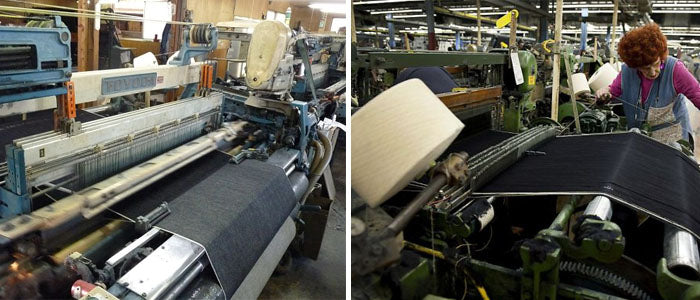Japanese vs. American Denim

Fabric origin is perhaps the most heavily contested topic of conversation within the raw denim community. While American and Japanese mills undoubtedly stand at the forefront of selvedge denim production, offerings from the two countries differ greatly. Which is better? Neither. The priorities and preferences of the wearer should ultimately inform the decision between an American and Japanese fabrics. At Brooklyn Denim Co, we’re proud to offer a wide selection of raw jeans constructed from textiles from numerous mills. Here are a few things to consider when approaching your next raw purchase.
History:
When Levi Strauss & Co began selling workwear garments in 1873, they primarily utilized a 9oz unsanforized denim from Manchester, New Hampshire’s Amoskeag Mill. To accommodate the growing demand for their products, the company began buying raw materials from Greensboro, North Carolina’s Cone Mills in 1915, before making Cone their exclusive fabric supplier in 1922. Levi’s stayed loyal to the North Carolina powerhouse through the early 1980s, and continues to reproduce their highly sought after 12oz fabrics for the Levi’s Vintage Clothing collection. Though America still boasts a handful of small denim mills, Cone’s White Oak plant remains the primary stateside producer of selvedge fabrics. In addition to offerings from our own private label, jeans in the shop from brands like Tellason, Raleigh, 1st Standard Co, and Baldwin are constructed from White Oak fabrics.
Though Japan’s first denim brand Big John set up shop in 1940, it wasn’t until World War II that the country experienced a real demand for blue jeans. Many American G.I.’s took their Levi’s abroad, showcasing their jeans on a global scale and sparking a particularly enthusiastic response from Japanese civilians. Because of Japan’s rich history of textile production, the country quickly began to make jeans that looked and felt similar to the highly sought after, yet unavailable Levi’s 501. Japan now boasts a large roster of notable mills, with many producing proprietary fabrics for brands in our shop. 3sixteen utilizes Kuroki Mills denim, Japan Blue uses Collect Mills, Jean Shop relies on Kaihara Millls, and Big John produces its own fabrics. Because of it’s lack of centralized fabric production and tendency to weave exclusive fabrics for brands, Japan’s denim offers inherently unique characteristics when compared to textiles from Cone Mills.

- 3Sixteen's pocket bag mentions Japan's Kuroki Mills, while Tellason's waistband features a Cone Mill's White Oak Plant.
Machinery:
Cone Mills primarily weaves selvedge denim on American Draper x3 Shuttle Looms. Said to bounce off White Oak’s hardwood floors while in use, these heavy pieces of machinery lend a unique texture to the fabrics they weave. Though a popular myth within the denim world suggests that Cone Mills sold off its early machinery to Japanese textile producers, little to no evidence exists to corroborate this story. Japanese selvedge denim is generally woven on Toyoda shuttle looms that result in uneven, less consistent textures. Various Japanese mills have experimented with what these Toyoda looms are capable of, leading to a wider variety of selvedge fabrics.

- Left: A Toyoda shuttle loom in a Japanese mill. Right: A Draper x3 shuttle loom in Cone Mills’s White Oak Plant.
Texture and Fading:
As a result of Cone’s dominance in American selvedge denim weaving, products utilizing White Oak fabrics have a relatively consistent look and feel. While brands like Raleigh have worked closely with the mill to develop unique offerings like green wefts, broken twills, and stretch selvedges, Cone’s denim is generally characterized by its even texture and soft hand. Draper’s high-tension weaves result in a fair amount of visible white weft on the surface of completed fabrics. In addition to its soft texture, Cone denim is generally less rigid than its Japanese counterparts. Jeans constructed from White Oak fabrics are initially comfortable and quickly contour to the wearer’s body. Cone denim also begins to show signs of wear relatively quickly, with rich blues emerging at various points of stress. Over time, White Oak fabrics yield consistent fades, characterized by low-contrast and even discoloration. A well worn pair of jeans made from American selvedge denim looks and feels vintage.
Due to its far larger roster of mills, Japanese selvedge denim is much less consistent in look and feel when compared to American fabrics. Japanese mills have dabbled in more experimentation with textile production, resulting in innovative details like indigo warp/black wefts, natural persimmon dyes, and 7x4 twills. Generally speaking though, jeans constructed from Japanese selvedge denim share various distinct characteristics. Japanese denim tends to have a slubby, coarse, or uneven texture. It’s initially extremely rigid and starchy, feeling noticeably stiffer than offerings from America. As a result, these jeans usually takes longer to break-in. Fabrics contour to the wearer’s body at slower rate and initial signs of wear don’t emerge for several months. Though Japanese fabrics yield a wide variety of fades, they are typically characterized by a high-contrast patina. Vibrant white honeycombing occurs behind the knees and through the top-block. Light blue hues emerge throughout the thigh and knee. Phone and wallet fades are pronounced. Numerous shades of white and blue can be seen in close proximity to the fabric’s original dark indigo color on a well-worn pair of jeans constructed from Japanese denim.

- Left: A well worn pair of 3sixteens (14.75oz Kuroki Mills). Right: A well worn pair of Levi’s Vintage Clothing 501s (12.5oz Cone Mills).

Comments
Mindy —
When purchasing jeans made out of white oak cone denim, should I downsize or should I buy my normal size? Do they stretch at all??
Reese —
Fantastic article! We’re doing a raw japanese denim for SS18.
Zac —
Awesome read!
Will —
Thank you for the detailed history! It was good to read!